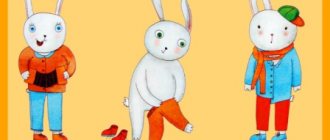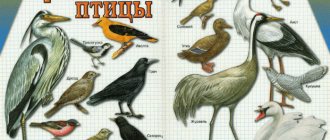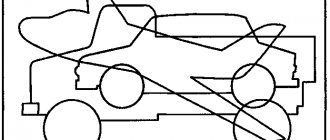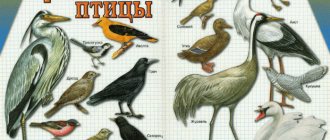Children's educational games, lessons, crafts
We study clothes. Lesson 1Educational activities for kids The first thematic lesson is Clothes. Classes are designed for children aged 2-3 years. What kind of clothes are there, what they are needed for, who designs them and where they get them. We suggest devoting several days to this topic to understand and consolidate the information. |
CardsYou can buy such cards in a ready-made set, or you can make them yourself. The format for the cards is at your discretion, but it should not be very small. Each card contains one item. At the bottom of each card is a signature, preferably in red and block letters. Pictures can be cut out from magazines, gradually collecting the required number. |
Clothing: blouse, skirt, dress, shirt, tracksuit, apron, trousers, suit, jacket, tie, jacket, jeans, sundress, sandals, shoes, slippers, sweater, hat, handkerchief, pajamas, T-shirt, sneakers, coat, raincoat, socks, scarf, shorts, gloves, mittens. Children's clothing: booties, rompers, bib, vest, cap. Headwear: hat, baseball cap, Panama hat, scarf.
Game “Dress up the paper doll”Dress up a paper doll. Either a purchased kit or a homemade one. For small children, you can not attach clothes to the doll, but simply put them on top. The tasks can be different: The doll goes for a walk outside in winter - outerwear, the doll cooks - an apron, sleeps - pajamas, etc. At the same time, we tell you that each occasion has its own clothes, and we laugh together when mom (as if by accident) dresses the doll for the holiday in pajamas and a robe. Don’t think that these games are only for girls; boys also need to understand clothes. You can download and print the paper doll that you see in the picture on the left using the link below. Download: Dress up a paper doll >>> |
Let's play store
In this game you can use both cards and ordinary clothes pulled out of the wardrobe. But with cards, it will still be more convenient. Lay out the pictures on the table or floor, decide which of you will be the seller - the consultant. First, it’s better for mom to take on the role of a consultant. A buyer comes to the store and asks for help choosing a dress for a matinee or clothes for the street, and the consultant recommends his product from the store and offers to buy the right one. You can immediately buy in bulk, as if you need children’s clothing in bulk for the senior group of a kindergarten, and at the same time explain what wholesale sales are.
We come up with a pattern for the dress.
Cut out the silhouette of a dress from a white landscape sheet. Let the child make this ugly white dress a festive one, in which she herself would like to dress up. (Sketch). In this game we explain who fashion designers are and what they do. In the game you can draw on the dress, make appliques, stick pieces of plasticine. We study: pockets, collar, belt, button fasteners, lace….
Lesson summary: “Clothes and shoes” outline of a lesson on the world around us on the topic
Lesson topic “Clothing and footwear” Purpose: To expand knowledge about the names of clothing and footwear
Objectives: Educational: - To consolidate knowledge about already familiar names of items of clothing and footwear - To learn to compare, group, classify items of clothing and footwear - To consolidate seasonal concepts: winter, autumn, summer, spring, men's, women's, children's.
Educational: -Cultivate a friendly attitude towards peers. -Develop the ability to listen to others and not interrupt. -Cultivate an emotional response.
Developmental: -Develop attention, memory, thinking. -Develop coherent speech. -Expand words knowledge.
Correctional: -Form correct pronunciation. -Development of fine motor skills. -Development of visual attention.
Material: Pictures “Clothes”, “Shoes”.
Progress of the lesson:
1. Introductory part. -What time of year is it now (winter) -What do we wear when we go outside (child’s answer)
I lay out pictures of clothes in front of the child and say the name of the clothes together with the child.
-How can this be called in one word? (cloth)
I lay out pictures of shoes in front of the child, and say the name of the shoes together with the child.
-How can you call this in one word? (shoes) - Today you and I will talk about clothes and shoes.
2. Main part.
-Tell me, please, what are the clothes for? (to protect our body) -Who sews clothes? (seamstress, tailor) - From what? (from fabric) - That's right, clothes are made from fabric. Where can you buy clothes? (in the store) -What is the name of the store where clothes are sold? (clothing store) - What is the name of the store that sells shoes? (shoe shop)
I lay out cards with pictures of clothes in front of the child. (summer, winter, autumn, spring). Please separate clothes by season. -Well done. coped with the task. And now I will tell you riddles.
Puzzles.
We always walk together, looking like brothers, We are under the table at dinner, And at night under the bed (slippers)
To prevent your feet from getting wet when jumping through puddles, you need to put new boots on your feet.
Master, master, help, the boots are leaky. I’ll nail the nails stronger, and you’ll go visit today. (shoemaker)
If it’s raining, we don’t bother – we splash around briskly in the puddles. When the sun begins to shine, we should stand under the coat rack. (rubber boots)
Not shoes, not boots, But they are also worn by feet. We run in them in winter: In the morning - to school, In the afternoon - home. (felt boots)
Pictures of women's and men's clothing and shoes, as well as two baskets, are placed in front of the child.
The child should put pictures depicting clothes and shoes for girls in one basket, and in the second for boys.
-What are the names of clothes and shoes for girls? (women's) -What are the names of clothes and shoes for boys? (male) - That's right. Clothes and shoes are available for women and men. And if these clothes and shoes are for children, what will they be called? (children's)
3. Physical education minute
Our tailor was tired of sewing, he quickly got up from the table, straightened his shoulders, stretched, then he bent low, then stood on tiptoe, squatted, then warmed up, we can start work, now we won’t get tired for a long time.
The game "What's missing?"
The child closes his eyes, the teacher removes one card from the table with a picture of clothes or shoes. The child opens his eyes and guesses which picture is missing (I make sure that the child correctly names the names of clothes and shoes in the genitive case). For example: “We are out of mittens”, “We are out of coats”
4. Summary of the lesson.
-What did we talk about today? -What did you like most? -This concludes our lesson. Well done.
Correctional lesson for younger schoolchildren on the topic “Clothing”
Class for 1st and 2nd grade students on type 8 correctional cola.
Theme "Clothing". Abstract Description of the material : I offer a summary of a correctional and developmental lesson with children for students in grades 1 and 2 of a correctional school of type 8. In this lesson, children are offered various tasks and exercises to develop the cognitive sphere (attention, memory, mental operations), as well as the emotional-volitional sphere. This material will be of interest to teachers - psychologists, speech pathologists, primary school teachers, educators. Goal: correction and development of students’ cognitive processes with the help of specially selected games and exercises. Objectives: • consolidate children's knowledge about clothing; • develop auditory and visual attention, short-term and visual memory, general and fine motor skills. • develop cooperation skills and a positive attitude towards participation in the lesson. Equipment: ball, pictures of clothes, task cards, pens, pencils.
Course of the lesson
Introductory part. Organizing time. Greetings. Hello guys! Let's give each other a good mood! And to do this, call your neighbor by an affectionate name so that he will be pleased. Children stand in a circle. Exercise “Dwarfs - washerwomen” (consolidate a vocabulary of words on the topic “Clothing”) Once upon
a time there lived little gnomes in a house: /
walking in a circle
Toki, Peaks, Faces, Chicks, Mickey.
/ spring - squats
One, two, three, four, five, /
plates - spinning
The gnomes began to wash: /
imitation of movements
Toki - shirts, / alternate bending of fingers Spades - handkerchiefs, / starting with the big one.
Likas are panties, Chiki are socks. Questions: - Mickey was smart - he brought water to everyone.
What did the gnomes wash? Who listened carefully and can say that they washed Toki? - Well done. Go to the tables. Main part
Consolidation of concepts: winter and summer clothes. Instructions: Name the clothes that are drawn in the picture, what other clothes do you know? Color winter clothes blue, summer clothes green.
Exercise “Find a Pair” Instructions: Match blouses to skirts. Connect with lines.
Physical school Together we help mom, We rinse the laundry ourselves. Stand up bending over, move your arms left and right
One, two, three, four.
They stretched and bent over. They leaned over.
We did a good job.
They wipe their hands.
They will “rinse” again.
Exercise for fine motor skills of the hands “Complete the pattern” Instructions: Complete: a plaid skirt, striped trousers, a polka dot dress.
Exercise “Confusion” Instructions: what objects are hidden in the picture, circle them in different colors.
Finger gymnastics “Clothes” New mittens, warm, downy. / fists, palms
my grandmother knitted them for me, /
they make movements as if knitting.
She gave them to me and said: “Now my granddaughter’s hands won’t get cold.”
/ clench and unclench fingers Exercise “Find the differences”
Final part. Reflection. The psychologist invites the children to talk about what they did today, what games and exercises they liked, who did the best work, and who needs to be more attentive and active. - Well done everyone! Goodbye.
We recommend watching:
Correctional and developmental lesson for grades 1-2. Lesson summary for children with disabilities for grades 1-2. Body parts. Emotions Game techniques for the development of the emotional-volitional sphere in students of a correctional school Correctional lesson “Development of coordination of hand and eye movements”
Similar articles:
Summary of correctional lesson in 1st grade
Conversation in the senior group on the topic “What are clothes for?”
Conversation in the senior group “Why do people need clothes?”
Target:
give an idea of why people need clothes. Note that at different times of the year a person changes clothes depending on seasonal changes. Differentiate between men's and women's clothing. Create a desire to help those who need help, and receive satisfaction from it.
Progress
of the lesson:
- Guys, look, we have a lot of paintings with different seasons. And it’s hard to guess which picture shows what. Let's try to figure it out.
- What season? (Summer).
- How did you guess? (Children list various natural signs).
- Look, can you guess what time of year it is by looking at your clothes? (Yes. People are dressed in hats, sundresses, shorts, etc.).
(Further, all further seasons of the year are determined.)
— Have you noticed, guys, the weather changes all year round, and people’s clothes change.
- Guys, why do people need clothes? (To be beautiful, fashionable, to avoid getting sick in the cold in winter, to protect your skin from the sun in summer, to protect your body from dust, etc.).
- Well done! You know everything, but the dolls Valya and Vova need to get ready for a long trip for a whole year, and they don’t know what things to take with them so that they will be comfortable in any weather. Want to help them get ready for their trip? (Yes).
— What is the weather like in summer? (Hot, stuffy, etc.).
— What clothes and shoes will Valya need? (Sundress, Panama hat, swimsuit, flip-flops).
-What clothes will Vova need? (Shorts, sports T-shirt, cap, sneakers).
-But autumn will come soon. The weather will change. What will the weather be like? (Cool, rainy, cloudy, etc.).
— What clothes will Valya need? (Sweater, skirt, coat with hood, tights, boots, hat, etc.).
— What clothes will Vova need? (Jacket, trousers, sweater, hat, tights, boots).
— After autumn, winter will come imperceptibly. What will the weather be like in winter? (Cold, frosty, blizzard, etc.).
-What clothes will help keep Valya warm in winter? (Fur coat, fur hat, mittens, warm boots, scarf, etc.).
— What clothes will Vova need? (Sheepskin coat, fur hat, gloves, warm socks, boots, etc.).
— After a frosty winter, spring will come. What's the weather like in spring? (Cool, sunny, rainy).
— In the spring, Valya and Vova will need the same clothes and shoes as in the fall.
- That’s how much clothes and shoes Valya and Vova have, but in any weather it will be cozy, comfortable, beautiful, etc.
- But where should we put so many things?
— What can you use to transport clothes and shoes? (In a bag, in a package, in a suitcase, in a backpack, etc.).
The dolls thank the children for their help.





